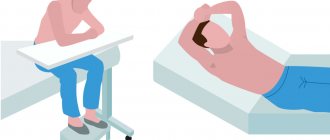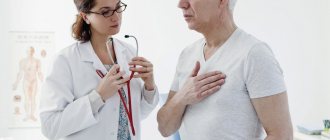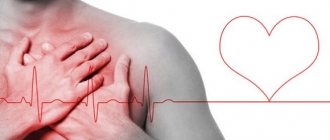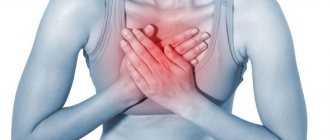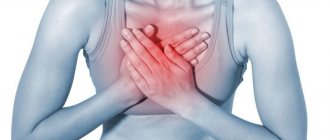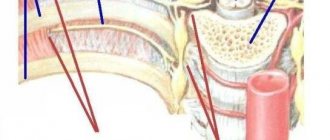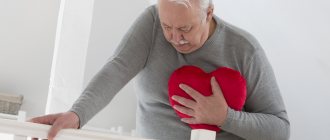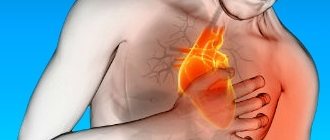Children often complain of chest pain, but it is rarely associated with heart disease or gastrointestinal tract inflammation or inflammation of the osteochondral joints. More often, chest pain in a child appears after physical activity and sports training, it is associated with muscle tension, sometimes due to psycho-emotional stress at home or at school, and is associated with the child’s internal anxiety.
If your child constantly complains of chest discomfort or pain for no apparent reason, consult a pediatrician to rule out serious diseases (heart, lungs, stomach, etc.).
URGENT CARE
Call an ambulance if your child:
- elevated temperature
- lethargy
- chest pain
- cough
- dry cough
- sudden shortness of breath appeared
- severe chest pain (suspicious pneumothorax)
THE DOCTOR'S CONSULTATION
Contact your doctor if your child complains of palpitations and difficulty breathing or persistent or very severe chest pain at rest.
ATTENTION!
If your child has persistent chest pain or gets worse with exercise, you should see a doctor. If chest pain appears after an injury, it is necessary to exclude a hip fracture, pneumothorax (collapsed lung), and other injuries to internal organs.
| ASK YOURSELF A QUESTION | POSSIBLE REASON | WHAT TO DO |
| Is the child physically active, plays sports, grows and develops normally, has a good appetite, is breathing normal? | Costochondritis (inflammation of the osteochondral joints of the ribs), muscle strain | If there is no improvement within 2-3 days, contact your pediatrician . Limit physical activity for a couple of days. |
| The child is healthy, he has difficulties with school and relationships with peers are tense, the atmosphere in the house is tense, chest pain appears at rest, lasts 1-2 minutes? | Nonspecific chest pain | Consult with your pediatrician ; a delicate and skillful approach will help identify psychological causes of pain and exclude organic causes of the disease. |
| The child suffered a viral infection, his temperature rose, and he developed a cough and weakness, increased breathing and wheezing | Pneumonia | It is necessary to call a pediatrician to choose treatment tactics |
| The child complains of a sour taste in the mouth and a burning sensation, grows and develops according to age, sometimes vomits, sometimes wakes up at night with pain in the chest or upper abdomen? | Diseases of the gastrointestinal tract | Raise the head of the bed to prevent acidic contents from the stomach from entering the esophagus. Avoid foods that cause heartburn (coffee, chocolate, tomatoes, etc.) Contact your pediatrician for an examination and examination. |
| Does your child have chest pain after physical activity, dizziness and blurred vision? Are there complaints of increased heart rate at rest, is the child pale or turns blue after physical activity? | Heart diseases | It is necessary to call a pediatrician to determine the causes |
| Is there swelling of the joints and their pain, chest pain at rest? | Juvenile rheumatoid arthritis | An examination by a pediatrician is required to determine the causes and consultation with specialists. |
FOR INFORMATION
Pneumothorax as a cause of chest pain
Collapse of the lung (or part of it) - pneumothorax - causes acute chest pain and sudden onset of shortness of breath. Spontaneous (sudden, without apparent cause) pneumothorax occurs in children, although it is most common in men 20-40 years old. Children with chronic lung diseases (for example, cystic fibrosis) are most prone to this, but pneumothorax occurs in healthy children, more often in thin teenage boys. Spontaneous pneumothorax occurs when the lung tissue ruptures, allowing air to leak from the lung into the pleural space. If this "leakage" occurs slowly, the baby will experience chest pain without other symptoms. In this case, the gap, as a rule, closes on its own, and the free air is absorbed. Otherwise, a large accumulation of air in the pleural part can lead to compression of the lung or part of it; In this case, severe chest pain, dry cough, and sudden shortness of breath occur. The child needs to be provided with peace and fresh air. Immediate medical attention is required.
Chest pain when moving: causes
The causes of pain and discomfort in the chest may be problems with the musculoskeletal system, diseases of the digestive system, cardiac and pulmonary pathologies. In each case, the pain will have a different nature and different accompanying symptoms.
Cardiovascular diseases
If you experience pain in the middle of your chest when moving, the doctor will first suspect you have a heart pathology. When walking with heart pathologies, the muscle may lack nutrition, resulting in pain. The cause may be atherosclerosis of the coronary arteries and even myocardial infarction. In this case, the pain begins from the back wall of the sternum, gradually the pain moves to the arm and neck, and begins to hurt in the front of the chest. This creates a feeling of burning and pressure.
Spinal diseases
Chest pain when moving often accompanies diseases of the spinal column. The problem may be the presence of an intervertebral hernia, calcification of ligaments, osteochondrosis and other pathologies. Depending on the cause, a person may have difficulty raising their arms, or the skin may tingle or feel numb in areas. With scoliosis, the picture is complemented by a significant or minor curvature of the spinal column.
Pulmonary diseases
If you experience chest pain when moving, you can suspect a pathological process in the lungs - pneumopleuritis, pneumothorax, or a neoplasm. Pain in the sternum may be accompanied by coughing, shortness of breath, and difficulty breathing even at rest. Each condition cannot be delayed, so you need to see a doctor as soon as possible.
Gastrointestinal diseases
If a person has chest pain when moving, such pain may be a reflection of pathological processes in the digestive organs. There can be a lot of reasons, including peptic ulcer, the onset of gastritis
or its exacerbation (with chronic course), intestinal obstruction and other diseases. First, the pain occurs in the abdomen, then moves to the chest, and during movement it intensifies even more.
Chest injuries
Often, when moving, chest pain occurs when a person is injured. You need to be concerned about your condition if you have recently:
- fell;
- received a blow to the sternum;
- lifted weights, etc.
The reason could be that you turned around unsuccessfully or lifted something heavy, thereby damaging a muscle or ligament, which causes pain behind the sternum when walking and even inhaling, or in a crack or fracture that has just appeared. How much the right chest hurts when you move will depend on how serious the injury you sustained. The condition is especially dangerous if not only the structures of the musculoskeletal system are damaged, but also internal organs, which is fraught with very serious consequences. In such a situation, you should immediately visit a neurologist
, who will probably refer you for
an X-ray
or
MRI
.
Neoplasms
“The right side of the chest hurts a lot when moving” - patients who, after diagnosis, find a tumor in one or both lungs, in the stomach or other organs, come to the doctor with this complaint. The nature of the tumor can be different, and the reason for the pain syndrome is that the tumor, growing, puts a lot of pressure on nearby tissues. This pressure causes discomfort, pain, and a feeling of heaviness. Depending on the location of the neoplasm, accompanying symptoms are added - cough and shortness of breath, if the place of formation is the lungs, digestive problems, if the stomach, etc.
Prevention recommendations
- Warm up more often, do physical exercise, swimming, yoga or fitness;
- Try to keep your back straight while walking and sitting;
- Avoid drafts, hypothermia, do not swim for a long time even in warm water;
- Avoid excessive physical exertion and lift heavy objects;
- Avoid sharp turns and bends;
- Avoid stressful situations, overwork;
- Monitor your diet and weight;
- Give up bad habits: smoking and alcohol;
- Get a preventative checkup every year.
How to relieve pain. First aid
If, when moving, pain appears in the chest on the right, you need to understand how to alleviate the condition. First of all, provide yourself with peace and opportunity to relax. A warm bath and gentle massage on the area where the pain is also helpful. Such methods are optimal if the cause of pain on the left side is spinal pathology. Medical assistance may consist of taking non-steroidal anti-inflammatory and analgesic drugs. The most important thing is to use pain relief methods only to alleviate the condition before visiting a doctor, but under no circumstances use them constantly, ignoring the need to visit a doctor.
Treatment of chest pain
First of all, a diagnosis is carried out to identify the root cause of chest pain. If spinal pathology is detected, radiography or MRI examination is most often prescribed. If joints are affected, ultrasound and also MRI of the joint are prescribed. A joint puncture may be necessary.
Treatment includes taking medications that relieve pain, inflammation, muscle spasms, and restore pinched nerves. Physiotherapy and physical therapy are also prescribed, which improve blood circulation, metabolic processes, and strengthen the muscles of the back and chest.
Treatment
If you have pain in the chest when moving your arms, the doctor will prescribe treatment for you depending on the pathologies that caused the pain. If you have problems with diseases of the gastrointestinal tract, to alleviate the condition, you need to cure the ulcer or gastritis before the pain subsides. In the case of lung pathologies, you will need to take antibiotics or even undergo surgery. Treatment of the spine in a condition where pain in the chest on the left appears when moving, may include taking anti-inflammatory drugs, applying ointments, massage and physical exercises prescribed by a neurologist
for each case individually.
Dangerous complications
Against the background of constant pinching and inflammation of the spinal nerves, intercostal neuralgia develops. There is constant severe pain in the entire chest or on one side, which intensifies with movement, deep breathing and coughing. There is a sensation of skin numbness, burning or tingling.
Spinal diseases are also dangerous due to other complications: decreased and loss of mobility, paralysis, and disability. The same complications occur with advanced arthritis of the shoulder joint.
Abdominal pain after running
Abdominal pain may occur below or under the ribs. The pain may also occur with a burning sensation, tingling or nausea. Despite the difference in the localization and course of painful sensations, the cause is most often one.
After running, the stomach may hurt due to the outflow of blood from the intestines, which disrupts the normal functioning of the gastrointestinal tract and, as a result, the digestive system is not able to fully cope with the load placed on it.
The second option for the occurrence of pain appeared relatively recently. New Zealand scientists have suggested that the cause of abdominal discomfort after running may be an increase in fluid content that accumulates in the intestinal area. As a result, the intestines increase in volume and begin to put pressure on the diaphragm.
avoid symptoms by following simple rules:
- Limit your food intake 2-3 hours before your run so that by the time of exercise your digestive system does not need to absorb the foods you eat.
- Drink minimal amounts of water during exercise. It is enough to take 1-2 sips.
- Master your breathing technique while running. Try to pull in your stomach and take 2-3 quick breaths and exhalations to increase the tone of your abdominal muscles.
If a feeling of nausea appears as a result of running activity, then the reason lies in the first option (blood outflow from the digestive system) or the presence of specific diseases (exacerbation of gastritis, ulcer formation). In this case, consult a doctor and undergo an abdominal ultrasound.
Foot pain after running
The occurrence of pain in the foot may indicate a structural disorder or damage to the muscles and ligaments. As a rule, pain in the foot occurs due to flat feet of the 1st degree, when the catalyst for pain is active physical activity.
For flat feet, it is recommended to use special shoes that follow the pronation of the foot. You can’t buy these shoes in a regular sports store, so you’ll have to place an individual order.
The second type of pain may be a violation of the integrity of ligaments and muscles. In this case, there is a chance that the problem will go away on its own. If a painful focus is observed in the heel and you are at puberty, then the reason is precisely the maturation of the body. If the body has long been formed, then you should consult a doctor.
Paying attention to your health is the key to long and painless runs. Treat your body with due attention and try to understand the cause of unpleasant sensations.
Causes of discomfort
Cardialgia refers to pain in the heart area that occurs due to myocardial pathology or diseases of other structures of the chest cavity. The mechanism of this symptom is associated with the peculiarity of the influence of running on the human body.
Jogging or sprinting, cycling, swimming are cardio workouts. These sports are aimed at increasing the tidal volume of the lungs, which improves the saturation of organs and tissues with sufficient oxygen. In addition, during exercise, the heart rate increases and metabolic processes accelerate.
Pain in the heart area when running is caused by the following reasons:
- Insufficient physical training of the athlete . High intensity exercise is a serious stress for an untrained person. Performing exercises and increasing the load trigger the processes that are necessary for the adequate functioning of the body in such conditions. The accumulation of under-oxidized products, a sudden acceleration of blood flow and respiratory rate disrupt the adaptive capabilities of the human body.
- Cramps in the chest muscles . The intercostal muscles take part in the act of breathing with a deep or rapid rhythm. In addition, their involuntary contraction occurs during each fast step on the treadmill. Depletion of glycogen reserves and insufficient oxygen supply develop convulsions, which cause pain in the heart area. A distinctive feature of this symptom is a clear localization (you can point with your finger) or increased pain on the left when bending to the right side (due to stretching).
- Heartburn . Jogging increases intra-abdominal pressure, as a result of which the cardiac sphincter of the stomach (the muscle at the border of the organ with the esophagus) relaxes. In this case, its contents are thrown upward, and due to the interaction of hydrochloric acid with the mucous membrane of the esophagus, a burning pain occurs behind the sternum.
- Pathology of the lungs . Diseases of the respiratory system (bronchial asthma) cause heart pain during running due to inadequate oxygenation of the blood.
The most serious cause of discomfort in the chest when playing sports is angina pectoris. This diagnosis characterizes insufficient blood supply to the heart due to damage to the coronary vessels. During training, the myocardium's need for oxygen and nutrients increases. With vascular incompetence, ischemia and pain occur, which are accompanied by shortness of breath, nausea, vomiting, increased sweating and dizziness.
